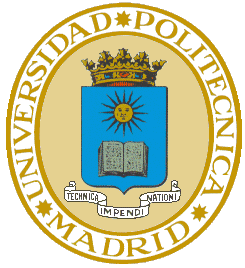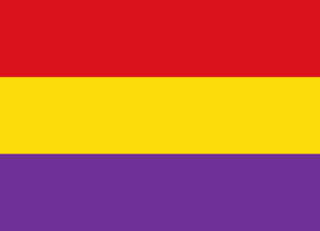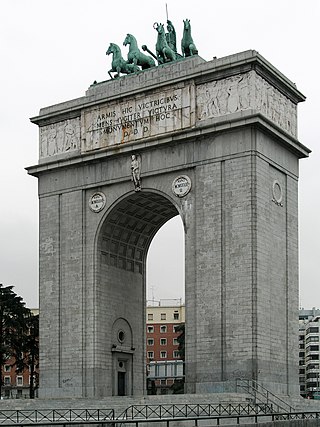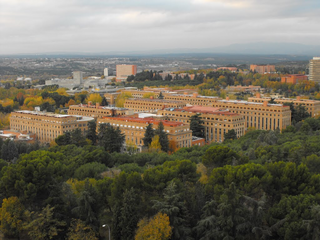This article has multiple issues. Please help improve it or discuss these issues on the talk page . (Learn how and when to remove these template messages)
|
| Battle of Ciudad Universitaria | |||||||
|---|---|---|---|---|---|---|---|
| Part of the Siege of Madrid of the Spanish Civil War | |||||||
 General view of the University City. | |||||||
| |||||||
| Belligerents | |||||||
| Durruti Column | | ||||||
| Commanders and leaders | |||||||
| | Div. Gen. Francisco Franco Lt. Col. Carlos Asensio Cabanillas Lt. Col. Francisco Delgado (WIA) Lt. Col. Mohamed Meziane (WIA)} | ||||||
| Strength | |||||||
| Central Army • 11,000 International Brigades • 1,800 Durruti Column • 1,400 militiamen | Army of Africa • 3,000 regulares • 18 light tanks | ||||||
| Casualties and losses | |||||||
| high | high | ||||||
The Battle of Ciudad Universitaria was a battle at the beginning of the Siege of Madrid in the Spanish Civil War. The battle happened at the new campus of the Ciudad Universitaria from 15 to 23 November 1936. The battle caused the frontline in this part of Madrid to stabilize for most of the war. The republican militias' objective was the defense of the capital at all costs, and for that it was necessary to stop the advance of General Varela's troops of the Army of Africa. Conversely, the attackers aimed to conquer the city as fast as possible. The persistence and tenacity of both sides in the battle meant an inflection point in the Spanish Civil War, partly because it was the first time that Franco's troops were stopped. The campus was also one of the most long-lasting confrontation points during the Spanish Civil War. The resistance shown in Madrid raised the morale on other fronts of the Republican government's controlled zone.
Contents
The end of the battle on 23 November 1936 was caused by a change in strategy by the attackers. The confrontation involved the participation of troops that belonged to the newly formed International Brigades, as well as heavy military materiel from the Soviet Union. The attackers received materiel and troops from Germany and Italy. The battle was one of the first times in history in which aerial bombing was used against a civilian population.
On 8 November 1936, General Varela's planned frontal assault started with an initial approach to the Casa de Campo. This attack moved the focal point of the attack to the northeast to occupy the zone between Ciudad Universitaria and Plaza de España. This first frontal attack was very bloody on both sides and involved a slow advance of the central axis of effort through the Casa de Campo to a stream of the river Manzanares. At the stream, the attackers saw the necessity of advancing through the bridges held by the militia troops. After various failed attempts to cross the Manzanares, they reached the other side through the space between two bridges. The battle itself started on 15 November, spreading the conflict throughout the campus. The fierce violence for occupying the city and the determination to stop the advance remained on both sides. Both sides began to run out of tactics as the death count rose, and the battle was carried out between the faculties and diverse buildings on the campus. Fighting inside the buildings, room by room, floor by floor characterized the confrontation. After a whole week of intense fighting and slow advance, General Franco had a meeting on the Cuartel General de Leganés, and on 23 November, the attackers' strategy changed: they would indirectly attack Madrid with a maneuver on the Las Rozas-Húmera axis (nowadays a neighborhood in Pozuelo de Alarcón) less than 2 kilometers northeast of the campus, which gave way to other battles like the Battle of Jarama (February 1937) and later the Battle of Guadalajara (March 1937). The campus' front line was wedge-shaped, with the Clínico at the tip, and remained practically the same for the rest of the war. Even though the front stayed the same, there was a fierce battle in the Ciudad Universitaria and Parque del Oeste with mines and countermines, all with unsuccessful infantry offensives until 28 March 1939, when the colonel Segismundo Casado surrendered the city to the attacking troops.
As a result of the battle, the campus and adjacent parts of the city were severely damaged. Ironically, the buildings were never used as a university but instead as a battlefield. It was not until years later that it was possible to do normal academic activities in some buildings. The war caught the university in the middle of a transition period, since many of the faculties that were in the urban center were slowly integrating with the newly-built campus. The war came unexpectedly, and the facilities were used for battle instead of for education. After the war, the Nationalist authorities reconstructed the university, rebuilding many of the sections during the 1940s. Several monuments were also built, dedicated to the commemoration of the victory of Franco's army, including the Arco de la Victoria built between 1950 and 1956 and the Monumento a Los Caídos Por España (nowadays the headquarters of the Junta Municipal del Distrito de Moncloa-Aravaca). The scars that the battle left have been hidden by the reconstruction of the faculties and the rebuilding of the surrounding Moncloa-Aravaca district, as well as the consequences of the urbanization of the 1970s, and remodeling projects like the burying of the M-30 and the creation of parks on the shore of the Manzanares like Madrid Río.

















